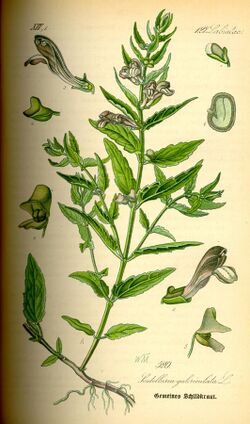Biology:Scutellaria galericulata
| Scutellaria galericulata | |
|---|---|

| |
| 1885 illustration[1] | |
| Scientific classification | |
| Kingdom: | Plantae |
| Clade: | Tracheophytes |
| Clade: | Angiosperms |
| Clade: | Eudicots |
| Clade: | Asterids |
| Order: | Lamiales |
| Family: | Lamiaceae |
| Genus: | Scutellaria |
| Species: | S. galericulata
|
| Binomial name | |
| Scutellaria galericulata | |
Scutellaria galericulata, the common skullcap, marsh skullcap[3] or hooded skullcap, is a hardy perennial herb native to northern areas of the Northern Hemisphere, including Europe, Asia, and almost all of Canada. It is a member of the mint family. The form is upright and is usually 20-45 centimeters in height,[4] sometimes reaching up to 80 cm.[5] It is a wetland-loving species and grows along fens and shorelines. The blue flowers are 1 to 2 centimeters long. The flowers are in pairs and are all on the same side of the stem. The flowers do not appear at the top of the stem.
The plant is native to many parts of the world and, as such, is known by a variety of names. The Latin galericulata means "hooded", relating to the length of the flower's tube being much longer than the calyx.[4] The variation epilobiifolia translates as leaves like willow-herb, and refers to the slightly serrated long thin leaves which look similar to those of the genus Epilobium.
Medicinal uses
The genus Scutellaria has numerous medicinal uses and various species of skullcap are used in the same way. The traditional uses of common skullcap should not be confused with those of other Skullcaps as there are over 200 different species of Skullcap and they are not all used in the same way. Blue skullcap (S. lateriflora) is accepted as the "skullcap" used in traditional North American medicine, however common skullcap shares many of the same active chemicals and is used as a substitute in Britain and Europe.[6] Common skullcap (S. galericulata) is also often used in the same way as Western skullcap (S. canescens) and Southern skullcap (S. cordifolia), all of which are genetically similar.[7]
Blue skullcap and common skullcap are mainly known for their traditional use as mild anxiolytics in the form of herbal teas, tablets, capsules, dried leaf for smoking and oral liquid preparations, often in combination with other medicinal herbs.[citation needed] The aqueous extract of the flowering parts have been traditionally used by Native Americans as a nerve tonic and for its sedative and diuretic properties.[8]
Pharmacology
| Chemical | Part | Concentration (mg/g) |
|---|---|---|
| baicalin | Leaf | 10[9] |
| chrysin-7-glucuronide | Plant | 27[9] |
| tannin | Plant | 28-35[10] |
It is used in skin lightening.
See also
References
- ↑ Prof. Dr. Otto Wilhelm Thomé Flora von Deutschland, Österreich und der Schweiz 1885, Gera, Germany
- ↑ "Scutellaria galericulata". IUCN Red List of Threatened Species (IUCN) 2014: e.T19210380A42321061. 2014. doi:10.2305/IUCN.UK.2014-1.RLTS.T19210380A42321061.en. https://www.iucnredlist.org/species/19210380/42321061.
- ↑ "Scutellaria galericulata". Natural Resources Conservation Service PLANTS Database. USDA. https://plants.usda.gov/core/profile?symbol=SCGA4.
- ↑ 4.0 4.1 "Scutellaria galericulata". http://www.plant-identification.co.uk/skye/labiatae/scutellaria-galericulata.htm.
- ↑ Jepson Manual Treatment
- ↑ R. B. H. Wills, D.L. Stuart, Generation of High Quality Australian Skullcap Products, 2004, ISBN:0-642-58730-2, ISSN 1440-6845 http://www.rirdc.gov.au/reports/EOI/04-020.pdf
- ↑ P. Wolfson, MD, and D. L. Hoffmann, FNIMH, Alternative Therapies, Mar/Apr 2003, Vol. 9, No. 2 75.
- ↑ Millspaugh, C. F. American Medicinal Plants; Dover Publications: New York, 1974; pp 469-472
- ↑ 9.0 9.1 P.H. and Horhammer, L., Hager's Handbuch der Pharmazeutischen Praxis, Vols. 2-6, Springer-Verlag, Berlin, 1969-1979.
- ↑ Lawrence, B.M., Essential Oils 1976-1977, Essential Oils 1978, Essential Oils 1979-1980.
External links
| Wikimedia Commons has media related to Scutellaria galericulata. |
- USDA Plants Profile
- Photo gallery
- Dr. Duke's Phytochemical and Ethnobotanical Databases
- Washington Burke Museum
Wikidata ☰ Q158111 entry
 |


